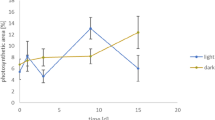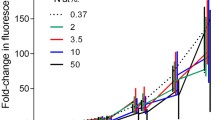Abstract
Colonial marine invertebrates are characterized by their ability to share resources among the modules of a colony. In most colonial groups, but particularly the Bryozoa, the dynamics of resource transport among modules is unknown. We developed radioisotope techniques to visualize and quantify the movement of carbon and sulfur-based compounds within colonies of the marine bryozoan Membranipora membranacea. The research was conducted in 1991 and 1992 in Friday Harbor, Washington, USA. Autoradiography, using X-ray film, was used to visualize the transport of both 14C and 35S, and a liquid scintillation counter was used to quantify transport of metabolites. We were able to localize feeding by introducing 10 μl aliquots of labelled algal cells with a microinjection syringe into a containment ring on the surface of the colony. The labelled cells were consumed by zooids feeding within the ring, but not by those outside. In time-course within the ring, but not by those outside. In time-course experiments, ≃15% of the ingested carbon radioisotope was transported from a source in the center of the colonies to the growing edges over a period of 48 h. Approximately 10% of the sulfur was transported from central to edge regions of colonies over 72 h. Transport of carbon isotope was unidirectional in all experiments, irrespective of whether colonies were fed near the edge or the center. Pulse-chase experiments revealed that up to 46% of the initial 14C radioisotope was lost from the colony to respiration and egestion in the 24 h following ingestion.
Similar content being viewed by others
References
Berrill NJ (1949) The polymorphic transformation of Obelia. Q Jl microsc Sci 90:235–255
Berrill NJ (1958) The Tunicata. The Ray Society, London
Best MA, Thorpe JP (1985) Autoradiographic study of feeding and the colonial transport of metabolites in the marine bryozoan Membranipora membranacea. Mar Biol 84:295–300
Boardmann RS, Cheetham AH (1973) Degrees of colony dominance in stenolaemate and gymnolaemate Bryozoa. In: Boardmann RS, Cheetham AH, Oliver WA (eds) Animal colonies: development and function through time. Dowden, Hutchinson & Ross, Stroudsburg, pp 121–220
Bobin G (1971) Histophysiologie du systeme rosettes-funicule de Bowerbankia imbricata (Adams) (Bryozoaíre Ctenostome). Les lipides. Archs Zool exp gen 112:771–792
Bobin G (1977) Interzooecial communications and the funicular system. In: Woollacott RM, Zimmer RL (eds) The biology of bryozoans. Academic Press, New York, pp 307–333
Chapman DF, Robson MJ, Snaydon RW (1990) Short term effects of manipulating the source:sink ratio of white clover (Trifolium repens L.) plants on export of carbon from, and morphology of developing leaves. Physiologia Pl 80:262–266
Chapman DF, Robson MJ, Snaydon RW (1991) The influence of leaf position and defoliation on the assimilation and translocation of carbon in white clover (Trifolium repens L.). 2. Quantitative carbon movement. Ann Bot 67:303–308
Conover RJ, Francis V (1973) The use of radioactive isotopes to measure the transfer of materials in aquatic food chains. Mar Biol 18:272–283
Cook CB (1971) Transfer of 35S-labelled material from food ingested by Aiptasia sp. to its endosymbiotic zooxanthellae. In: Lenhoff HM, Muscatine L Davis LV (eds) Experimental coelenterate biology. University of Hawaii Press, Honolulu, pp 218–224
Cook CB (1972) Benefits to symbiotic zoochlorellae from feeding by green hydra. Biol Bull mar biol Lab, Woods Hole 142:236–242
Cook CB (1983) Metabolic interchange in algae-invertebrate symbiosis. Int Rev Cytol (Suppl) 14:177–209
Crossland CJ, Barnes DJ, Cox T, Devereaux M (1980) Compartmentation and turnover of organic carbon in the staghorn coral Acropora formosa. Mar Biol 59:181–187
Cuhel RL, Taylor CD, Janasch HW (1981) Assimilating sulfur metabolism in marine microorganisms: characteristics and regulation of sulfate transport in Pseudomonas haldurano and Alteromonas lueto-violaceous. J Bact 147:340–349
Danckwerts JE, Gordon AJ (1989) Long-term partitioning, storage and remobilization of 14C assimilated by Trifolium repens. Ann Bot 64:533–544
Edmunds PJ, Spencer Davis P (1986) An energy budget for Porites porites (Scleractinia). Mar Biol 92:339–347
Goreau TF, Goreau NI (1960) Distribution of labelled carbon in reef-building corals with and without zooxanthellae. Science, NY 131:668–670
Harvell CD (1984) Why nudibranchs are partial predators. Ecology 65:716–725
Harvell CD (1990) The ecology and evolution of inducible defenses. Q Rev Biol 65:323–340
Harvell CD (1994) The evolution of polymorphism in colonial invertebrates and social insects. Q Rev Biol 69:155–185
Harvell CD, Caswell H, Simpson P (1989) Density effects in a colonial monoculture: experimental studies with a marine bryozoan (Membranipora membranacea L.). Oecologia 82:227–237
Harvell CD, Helling R (1993) Experimental induction of localized reproduction in a marine bryozoan. Biol Bull mar biol Lab, Woods Hole 184:286–295
Harvell CD, Padialla DK (1990) Inducible morphology, heterochrony, and size hierarchies in a colonial invertebrate monoculture. Proc natn Acad Sci USA 87:508–512
Lewis DH, Smith DC (1971) The autotrophic nutrition of symbiotic marine coelenterates with special reference to hermatypic corals. I. Movement of photosyntheic products between symbionts. Proc R Soc (Ser B) 178:111–129
Mackie GO (1986) From aggregates to integrates: physiological aspects of modularity in colonial animals. In: Harper JL, Rosen BR, White J. (eds) The growth and form of modular organisms. The Royal Society, London, pp 175–196
Marshall C (1990) Source-sink relations of interconnected ramets. In: van Groenendael J, de Kroon H (eds) Clonal growth in plants: regulation and function. SPB Academic Publishing, The Hague, Netherlands, pp 23–41
Muscatine L, Cernichiari E (1969) Assimilation of photosynthetic products of zooxanthellae by a reef coral. Biol Bull mar biol Lab, Woods Hole 137:506–523
Muscatine L, Hand C (1958) Direct evidence for the transfer of materials from symbiotic algae to the tissues of coelenterates. Proc natn Acad Sci USA 44:1259–1263
Palumbi SR, Jackson JBC (1979) Aging in modular organisms: ecology of zooid senescence in Steginoporella sp. Biol Bull mar biol Lab, Woods Hole 164:267–278
Pearse VP, Muscatine L (1971) Role of symbiotic algae (zooxanthellae) in coral calcification. Biol Bull mar biol Lab, Woods Hole 141:350–363
Penry DL, Frost BW (1991) Chlorophyll a degradation by Calanus pacificus: dependence on ingestion rate and digestive acclimation to food resources. Limnol Oceanogr 36:147–159
Rinkevich B (1989) The contribution of photosyntheic products to coral reproduction. Mar Biol 101: 259–263
Rinkevich B, Loya Y (1983) Oriented translocation of energy in grafted reef corals. Coral Reefs 1:243–247
Schmitz K, Kremer BP (1977) Carbon fixation and analysis of assimilates in a coral-dinoflagellate symbiosis. Mar Biol 42:305–313
Schopf TJM (1973) Ergonomics of polymorphism: its relation to the colony as the unit of natural selection in species of phylum Ectoprocta. In: Boardmann RS, Cheetham AH, Oliver WA (eds) Animal colonies: development and function through time. Dowden, Hutchinson & Ross, Stroudsburg, pp 247–274
Silén L (1977) Polymorphism In: Woollacott RM, Zimmer RL (eds) Biology of bryozoans. Academic Press, New York, pp 184–231
Taylor DL (1977) Intra-colonial transport of organic compounds and calcium in some Atlantic reef corals. Proc 3rd int coral Reef Symp 1:431–436 [Taylor DL (ed) Rosenstiel School of Marine Science and Atmospheric Science, University of Miami]
Thorington G, Margulis L (1981) Hydra viridis: transfer of metabolites between Hydra and symbiotic algae. Biol Bull mar biol Lab, Woods Hole 160:175–188
Trench RK (1979) The cell biology of plant-animal symbiosis. A Rev Pl Physiol L 30:485–531
Wardlaw IF (1990) The control of carbon partitioning in plants. New Phytol 116:341–381
Winston J (1977) The food of bryozoans. In: Woollacott RM, Zimmer RL (eds) Biology of bryozoans. Academic Press, New York, pp 233–271
Author information
Authors and Affiliations
Additional information
Communicated by M. F. Strathmann, Friday Harbor
Rights and permissions
About this article
Cite this article
Miles, J.S., Harvell, C.D., Griggs, C.M. et al. Resource translocation in a marine bryozoan: quantification and visualization of 14C and 35S. Marine Biology 122, 439–445 (1995). https://doi.org/10.1007/BF00350877
Received:
Accepted:
Issue Date:
DOI: https://doi.org/10.1007/BF00350877




